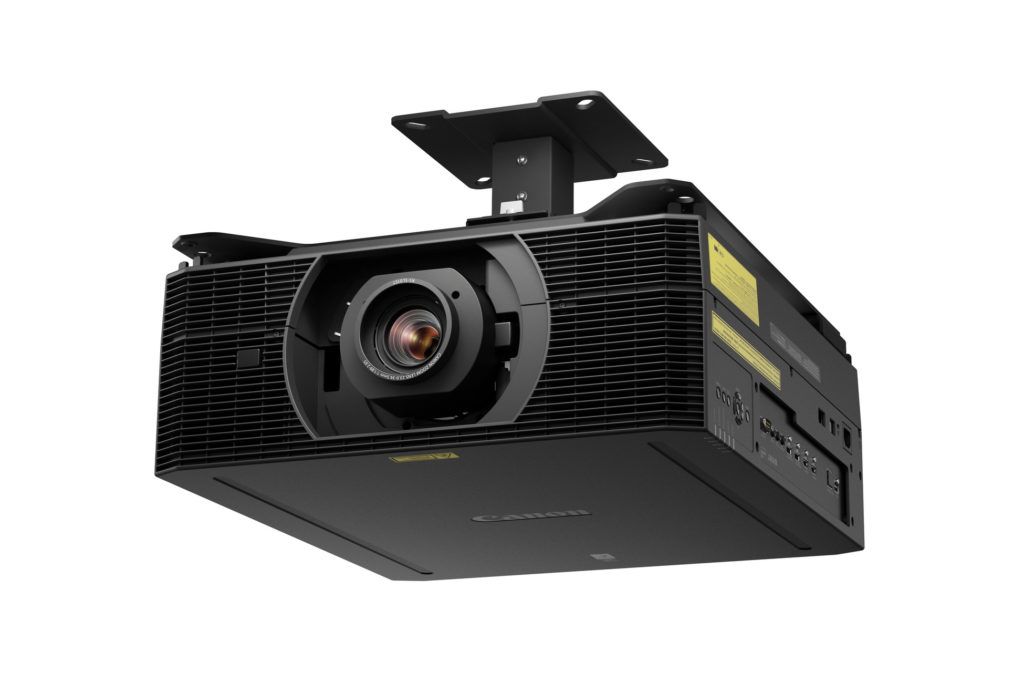Matthew Koshy, European product marketing specialist at Canon Europe, tells Auditoria about the company’s latest technology launches, his 2019 highlights and what this year holds for Canon.
Could you tell us about Canon’s 4K technology?
Canon’s 4K technology is featured across its entire range of products, from input to output. With world-class EF and RF lenses, to 4K video cameras, reference displays and projectors, Canon has built an input-to-output range that minimises negative influences to maintain the 4K image quality through transmission. The entire 4K Xeed range, from the Xeed 4K6021Z (pictured above) and 4K5020Z are capable of native 4K resolution, while the LX-MH502Z utilises pixel shifting technology to create UHD 4K resolution for those who are more price-conscious. Coupled with its professional video cameras – the XF705, EOS C200 and XA55 – they create a seamlessly integrated 4K imaging ecosystem.
Canon’s native 4K projectors will be on display at ISE this year, along with the 4K6012Z and RS-SL07RST 4K lens, which use the same precision-built glass featured in the acclaimed EF and RF lens ranges, creating high-resolution and true-to-life images that guarantee systems integrators can get the best from Canon’s 4K technology.
As Canon’s projectors are native 4K, they’re able to create scintillating detail because they do not upscale or downscale any of the content that is being fed into them. This means the user can view the content as it was intended to be seen. Visitors at the stand will be offered the chance to immerse themselves in a live 4K production simulation, showcasing our heritage in best-of-breed imaging solutions, guaranteeing optical excellence for system integrators.
What is Canon’s laser technology?
Canon prides itself in its ability to create laser projectors that are low in maintenance and easy to install, resulting in better image quality over a longer period. Canon’s laser technology is featured in its full Xeed projector range, boasting an adjustable brightness range from 20-100%, combined with 5,800-7,000 advanced lumens and 20,000 hours of projection. As no lamps need to be replaced, the downtime on these projectors is minimal. Canon’s laser light source can also cater to installs which require 360° projection by using it in portrait orientation for example. This makes it perfect for creative installations where the wish is to create unique image sizes and have downtime kept to a minimum without any sudden lamp warning lights coming up.
The immersive Inside Magritte exhibition at La Fabbrica del Vapore art museum in Milan, Italy, uses 29 of Canon’s Xeed laser projectors to animate and scale-up René Magritte’s work to cover the entire room. These laser projectors guarantee Magritte’s work is faithfully projected, with high brightness and bold colours that bring this work to life.
What are Canon’s 8K capabilities?
As the availability of 8K content grows, the ability to display and view it is becoming increasingly important. Canon will be exhibiting an 8K projection solution at ISE this year, in partnership with audiovisual solutions provider AV Stumpfl. The AV Stumpfl Pixera Two server will help deliver and manage the 8K content – captured using Canon cameras – ensuring Canon’s projectors can focus on delivering excellent 8K image quality that packs a punch.
Canon’s latest development of 8K broadcast lenses include the multipurpose portable lens 7×10.7B and Canon’s first box-type telephoto 8K lens, SP51x15.5B. A decade in the making, Canon’s 8K lenses are set to be used at the 2020 Tokyo Olympics, bringing viewers even closer to the action in stunning resolution. Canon has already experimented with 8K for a live video transmission of a rugby match in Japan. The match was captured with a Canon 8K camera and lens and transmitted to a Canon 8K HDR display and projector system comprising four Canon 4K HDR projector units, to achieve an impressive live viewing experience with a high dynamic range and wide colour gamut. A similar demonstration will be reconstructed on our stand to showcase the optical excellence of the 8K lineup.
What was the biggest highlight for Canon in 2019?
Our biggest highlight in 2019 was developing our 4K technology with the 4K6021Z projector. Building 4K technology into a 6,000-lumen native 4K projector that takes interchangeable lenses including our RS-SL07 lens was a massive landmark for Canon, as it shows our commitment to optical and imaging excellence. Along with this, the entire Xeed range has seen massive success with end users such as Dallmeier in Germany and the Naturalis Biodiversity Centre in the Netherlands, which have invested heavily in these projectors.
Additionally, the RS-SL06UW lens has also pushed on massively in the last year, as it’s still one of the most unique projector lenses on the market, with a 0.54:1 lens ratio and enormous vertical lens shift of 83%. This was particularly important to the Naturalis Biodiversity Centre in Lieden, which wanted to create a more immersive exhibition without visitors casting shadows on the projection. With this lens, they were able to keep our Xeed projectors close to the projection surface, but also high up on the wall to negate from any possible shadowing.
What does 2020 hold for Canon?
Looking forward to the year ahead, Canon will move its focus from individual products to systems and solutions that work as a cohesive package. One example is the robotic arm solution – provided by Denso – which will feature for the first time at ISE this year, showing how Canon PTZ cameras and its specialist analytics software can be used to create a robotics solution. This is emphasising how Canon is utilising its fleet of imaging hardware to also create software that will cater to new markets.
The demand for 4K resolution is still on the rise, due to the growing amount of 4K available to view. Canon will continue to grow its Xeed range, both in lamp- and laser-based WUXGA, but also within that lucrative native 4K laser market, which we feel we have a real advantage in.
The idea for 2020 is to move more into solutions rather than just imaging products. This is shown by our 8K demonstration at ISE this year. The collaboration with AV Stumpfl shows how we want to give our system integrators and end users an idea of a comprehensive solution involving our long-term partners such as Stumpfl.





